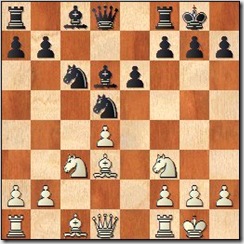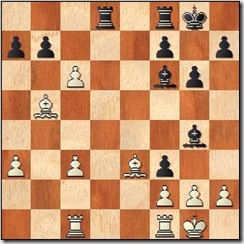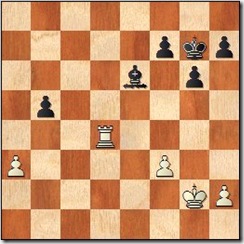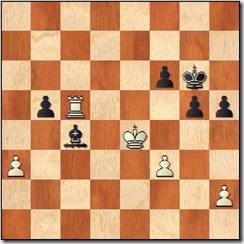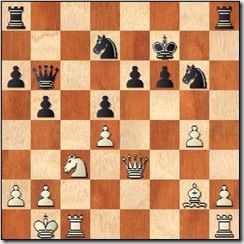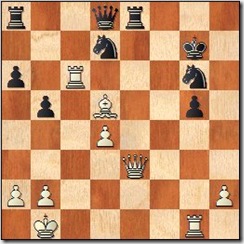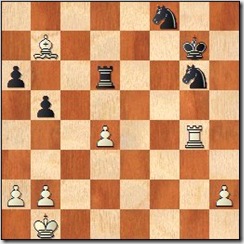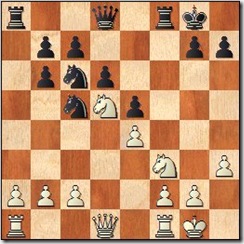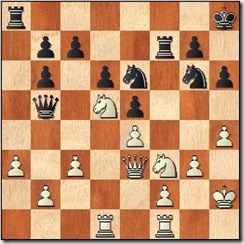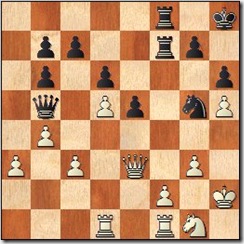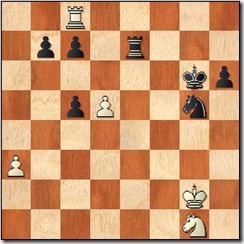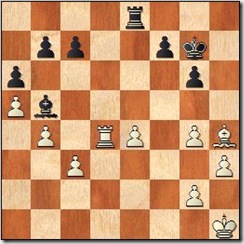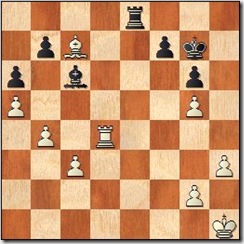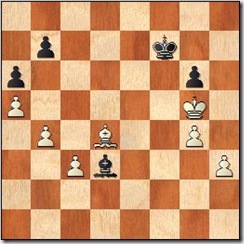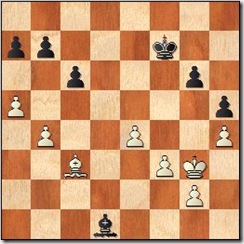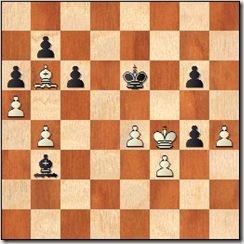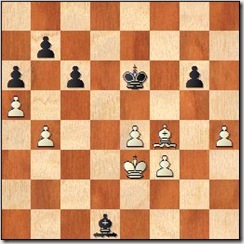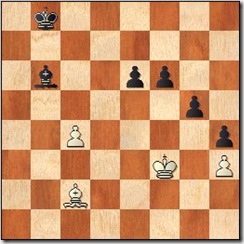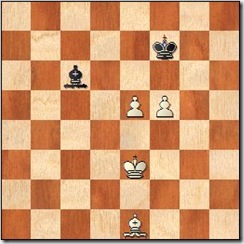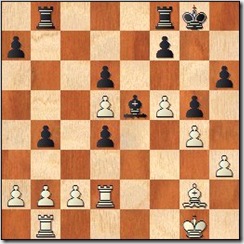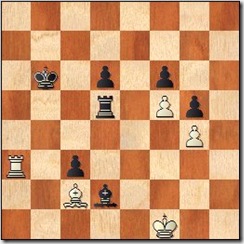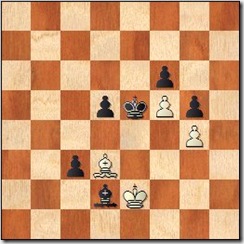In 2002 Keres memorial - Bobby Meng was provided a sensation result, tying for first place with Georgi Orlov and Jack Yoos among others, beating the new Canadian Champion Pascal Charbonneau in the process. I wrote a report about the tournament for En Passant, so here is the selection of Bobby`s games. I analysed 3 games in that article:
Meng-Wu
Pupols – Meng
Adam - Meng
(1) Meng,Fanhao - Wu,Howard [D42]
Keres mem 27th Vancouver (1.10), 17.05.2002
1.e4 c5 2.c3 Bobby is a loyal supporter of this move and it does bring him good results. 2...Nf6 3.e5 Nd5 4.d4 cxd4 5.cxd4 Nc6 6.Nf3 d6 7.exd6 e6 8.Nc3 Bxd6 9.Bd3 0-0 10.0-0 Diagram
10...Be7 [10...Nce7!?] 11.a3 [I prefer 11.Re1 , but Bobby usually goes for queenside play in these IQP positions] 11...Bf6 suddenly the game transposed into the major theoretical QGD line. White is doing well in this line, so I don't think Black's two move manoeuvre Bd6-e7-f6 was really worth the time investment 12.Be3 [Again, Bobby ignores main lines: 12.Be4 scores well for White] 12...g6 13.Rc1 Nxc3 14.bxc3 e5 [14...b6 15.Bh6 Bg7 16.Bg5 Qc7 17.c4 Bb7 18.d5 Ne5 19.Be4 Qd6 was Gelfand-Van Wely, 1998. The position soon simplified to a draw: 20.Bf4 exd5 21.Bxd5 Bxd5 22.Bxe5 Bxe5 23.Nxe5 Qxe5 24.Qxd5 Qxd5 25.cxd5 Rfd8 26.Rfd1 Rac8=] 15.Bb5 Bg4 16.d5 e4? a miscalculation [>=16...Ne7+/=] 17.dxc6 exf3 18.Qxd8 Raxd8 Diagram
19.Bc5? Now Black is doing ok again [19.cxb7!+-] 19...fxg2 20.Kxg2 bxc6 21.Bxf8 [21.Bxc6!? Rd3 22.Bxf8 (22.f3 Rc8 23.Be4 Rxc3 24.Rxc3 Bxc3 25.fxg4 Rxc5 26.Rc1 Bd4=) 22...Bh3+ 23.Kg1 Bxf1 24.Bc5! Bh3 25.Bxa7 Bxc3 26.Be4 Rd7 and Black is ok] 21...cxb5 22.Bc5 Rd3?! [>=22...a6] 23.f3 Be6 24.Rfd1 Rxd1 25.Rxd1 Bxc3 26.Rd8+ Kg7 27.Bxa7 Bb2?! [27...b4!? 28.axb4 Bxb4 29.Bd4+ Kh6; 27...Kf6] 28.Bd4+! Bxd4 29.Rxd4 Diagram
and White managed to win this endgame29...Kf6 30.Kf2 Ke5 31.Ke3 Bb3 32.Rd7 Ke6 33.Rb7 Bc4 34.Kd4 g5 35.Kc5 h5 36.Kd4 [36.Rxb5 Bxb5 37.Kxb5 is not more than a draw for White 37...Kd6 38.Kb6 g4 39.fxg4 hxg4 40.a4 f5] 36...f6 37.Rc7? [37.a4 Be2 38.Ke3 Bc4 39.axb5 was winning on a spot] 37...Kf5 38.Ke3 Kg6 39.Rc5 Kh6 40.Ke4 Kg6 Diagram
41.h4 [Bobby's calculation (or intuition?) is precise: 41.Rxc4 here (and earlier) does not win: 41...bxc4 42.a4 f5+ 43.Kd4 g4 44.fxg4 fxg4 45.a5 h4 46.a6 g3 47.hxg3 hxg3 and Black queens with check] 41...gxh4 [41...Be2 42.hxg5 fxg5 43.Rc6+ Kg7 44.Kf5 Bxf3] 42.f4 h3 43.Kf3 Bf1 44.Kg3 Be2(.) [44...Kh6 45.Kh4 h2 46.Rxh5+ Kg6 47.f5+! Kf7 48.Kg3] 45.Kxh3 Kf7 46.Kh4 Ke6 47.Rc2 Bd3 48.Rc3 Bf1 49.Kxh5 Kf5 50.Rc2 Bd3 51.Rf2 Ke4 52.Kg4 f5+ [52...Ke3 53.Rf3+ Ke4 54.Rh3] 53.Kg5 Ke3 54.Rb2 Ke4 55.Rb4+ Kd5 56.Kf6 Kc6 57.Ke5 Kc5 58.Rd4 Bb1 59.Rd5+ Kc4 60.Ke6 Bd3 61.Rxd3 1-0
(2) Pupols,Viktors - Meng,Fanhao [D12]
Keres mem 27th Vancouver (5.5), 19.05.2002
27...Kf7 In this game Bobby got lucky: having been outplayed, he is now receiving a couple of strong blows: [27...Kd8!?] 28.g5 fxg5 29.Nxd5!? exd5 30.Bxd5+ Kg7 Diagram
31.Rc6!? [31.Bxa8] 31...Qd8 32.Rg1 Re8 Diagram
33.Qc1? A strange decision, having conducted the attack with great energy White suddenly retreats. [Winning was 33.Qf3! Rf8 34.Qh5 Rf6 35.Rxf6 Nxf6 36.Qxg5 Nxd5 37.Qxg6+ Kf8 38.Rf1++-] 33...Rc8 34.Rxg5 Ndf8 35.Rxc8 Qxc8 36.Qxc8 Rxc8 37.Bb7 Rd8 38.Rg4 Rd6 Diagram
Black consolidated and went on to win this endgame with an extra piece. 0-1
(3) Adam,Valerian - Meng,Fanhao [C50]
Keres mem 27th Vancouver (3.4), 18.05.2002
1.e4 e5 2.Nf3 Nc6 3.Bc4 Bc5 4.0-0 Nf6 5.d3 d6 6.Be3 Bb6 7.h3 0-0 8.Nc3 Be6 9.Bxb6 axb6 10.Bxe6 fxe6 11.d4 Nd7 12.d5 exd5 13.Nxd5 Nc5 Diagram
I think this is Bobby's best game in the tournament: he manages to play around the White knight on d5 and his own knights start an impressive tango: the semi-open 'f' file, and the h2-h3 advance provide Black with good chances on the kingside.14.c3 Kh8 15.Qe2 Ne7 16.a3 Ng6 17.g3 White covered both d4 and f4, but now the Nf3 lacks support 17...Ne6 18.Qe3 h6 Bobby makes sure that White can never play Ng5, trading off a badly placed N 19.Rad1 Qd7 20.Kh2 Rf7 21.h4 Qb5 Diagram
playing on both flanks reveals a rather mature positional player22.h5 Raf8!? [22...Ne7?! 23.Nxe7 Rxe7 24.Nh4 would have allowed the White N to get to better squares, now he has to go down..] 23.Ng1?! [23.Nd2!?] 23...Ne7 24.b4 Nxd5 25.exd5 Diagram
25...Ng5
Very nice! Black traded off White's strong Nd5, and White is now left out with a passive Ng1 26.f3 Qd7 27.Kg2 Rf6! 28.Qe2 Qf7 29.g4 Rf4 30.c4 Qd7 31.Rde1 Kg8 32.Kg3 Kh8 33.Kg2 e4! Diagram
Now White's pawn structure collapses34.fxe4 Qxg4+ [34...Rxg4+ 35.Kh2 Rxf1 36.Rxf1 Rxe4 was probably an easier way to win - perhaps a bit typical for Bobby: if he sees a good continuation, he sometimes does not stop to look for anything better] 35.Qxg4 Rxg4+ 36.Kh2 Rxf1 37.Rxf1 Rxe4 38.Rf8+ Kh7 39.c5 bxc5 40.bxc5 dxc5 41.Rc8 Re7 42.Kg2 g6 43.hxg6+ Kxg6 Diagram
and having centralized his K, Black won without any difficulties 0-1
